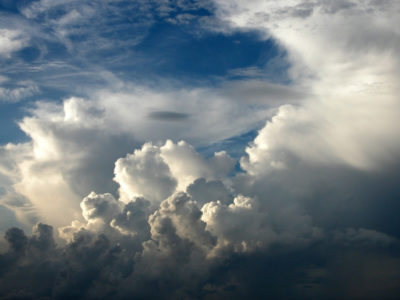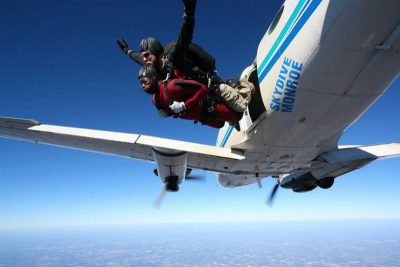Skydiving is an exhilarating sport that’s gaining in popularity. While many thrill-seekers cherish its high-adrenaline charm, the experience hinges significantly on weather conditions.
Certain skydiving weather conditions have the potential to rain on your parade. Since we are in the business of mitigating risk as much as possible, we have to consider which weather factors add too much risk, making it unsafe to jump altogether. For enthusiasts and newcomers alike, understanding the impact of weather on skydiving is crucial for safety and enjoyment. So, let’s delve into how weather can affect your skydive, explore the best weather for skydiving, and why it’s important to follow strict safety measures to ensure a successful skydive.
 Skydiving Weather Requirements
Skydiving Weather Requirements
Obviously, inclement weather is a significant deterrent for skydiving. But, what conditions are needed to skydive? According to the Federal Aviation Administration (FAA), for a skydive that is 1,200 feet above the surface and is less than 10,000 feet, you must be able to see with an unobstructed view for at least three miles and must maintain a distance of: 500 feet below clouds; 1,000 feet above clouds; and 2,000 feet horizontally away from clouds.
At or above 10,000 feet, skydivers must be able to see with an unobstructed view for at least five miles and must maintain a distance of: 1,000 feet below clouds; 1,000 feet above clouds; and one mile horizontally away from clouds. Winds need to be safe enough for the skydiver to operate the parachute which is subjective to the skydiver’s experience. Wind gusts above 14 mph can be dangerous and will prevent students from jumping.
How Does Weather Affect Skydiving?
Rain, clouds, and wind can all significantly impact various aspects of skydiving, influencing both the safety and overall experience of the jump. Here’s how different weather elements affect skydiving:
Skydiving in Cloudy Weather
Safety is the foremost concern in skydiving. Clouds obscure the ground, making it difficult for jumpers and pilots to see their landing zone. This lack of visibility increases the risk of landing in an unintended area.
Dropzones are equipped with well-manicured areas – free of debris – so that the skydiver doesn’t trip or land onto anything that may be deemed a hazard. If a skydiver has to land off of the dropzone, there is a potential to land on an uneven surface with power lines stringing across the land, on top of buildings, or even in the street! Yikes!
What’s more, reduced visibility from clouds can lead to mid-air collisions between jumpers.
Maintaining visual contact with other skydivers is crucial for coordinated group jumps and for looking out for other jumpers above, below, and all around you.
Skydiving in Rainy Weather
Skydiving in rainy weather is highly discouraged for several reasons that can compromise safety AND comfort. Raindrops at 120 mph speeds feel a bit pointy when hitting the skin, making the experience extremely uncomfortable. Not only is rain on a skydive unpleasant, but it can also distract jumpers, leading to potential errors during the jump.
Rain also has the potential to impact the skydiving equipment, making it heavier. Wet parachutes may not deploy or fly properly, and harnesses and toggles can become slippery, making it harder for the skydiver to control.
With rain, comes clouds and gray skies, making it hard to see both in the air and on the ground. As we’ve already discussed, poor visibility complicates navigation and landing – increasing the risk of accidents. Rain can also affect the performance of the skydiving aircraft, particularly during takeoff and landing. Wet conditions on the runway and in the air require pilots to exercise additional caution.
Skydiving in Windy Weather
Now that we’ve discussed the weather that we can see, let’s talk about dangerous weather that is invisible to the naked eye – wind! The wind is one of the most critical weather factors in skydiving because it not only makes it challenging to exit the aircraft safely – pushing jumpers off balance and increasing the risk of a chaotic exit and potential entanglements – but it can also seriously impact canopy control. Strong winds can cause the parachute to be pushed backward, oscillate, or even collapse.
Experienced skydivers are trained to adjust their landing techniques based on wind conditions, but for novices, strong winds pose a very dangerous hazard. So, what wind speed cancels skydiving? Well, it all depends on the type of jump you’re doing and the skill level of the canopy pilot. Skydiving centers closely monitor skydiving wind forecasts with AWOS (Automated Weather Observation System) and wind measuring tools to determine wind speeds and will often place jumps on hold when winds exceed safe limits (typically around 14 mph gusting).
Skydiving in Cold Weather
Another disguised weather component that can affect skydiving is temperature. While it’s rare that we will cancel skydiving plans due to temperature, skydiving in extreme heat or cold can be uncomfortable for some.
Skydiving in cold weather in particular presents its own unique challenges. Temperatures drop significantly as altitude increases so even if the temperature is relatively mild at ground level, the temperature at jump altitude can be 30 to 40 degrees cooler. Brrr! Exposed skin can suffer from frostbite in extremely cold conditions, especially during freefall when wind chill exacerbates the cold – fingers, toes, and facial areas in particular.

Cold weather can even affect the performance of skydiving equipment. Parachutes can become stiff and mechanical components, such as altimeters and automatic activation devices (AADs), may operate less efficiently in freezing temperatures.
Best Weather for Skydiving
What is the best weather to skydive in? The best skydiving forecast is characterized by blue skies, moderate temperatures, and light winds! Clear, blue skies provide excellent visibility, allowing skydivers to see the ground and other jumpers clearly. Temperatures around 70 degrees ensure comfort without the need for heavy thermal gear. Light winds around 5 mph, create stable conditions for landing your parachute.
Is the weather looking favorable in your area? Book your skydive with Skydive Monroe, Georgia’s premier skydiving center! Blue skies, friends!
Copyright © 2025, Skydive Monroe, All Rights Reserved.
DropZone Web Design & Marketing by Beyond Marketing, LLC



